World 🢖 Europe 🢖 United Kingdom 🢖 Gibraltar
Early human finds 🢔 Fossil finds 🢔 Biological wonders 🢔 Categories of wonders
Wonder
Gorham’s Cave
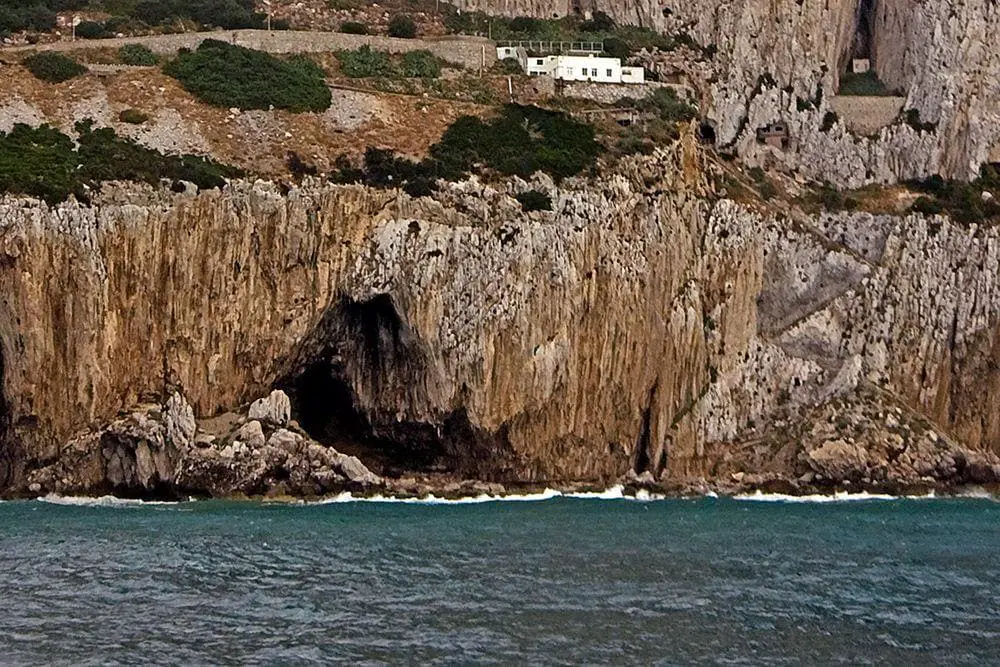
 In short
In short
The impressive Rock of Gibraltar hides many secrets but some of the most intriguing are linked to Gorham’s Cave. This could be the last refuge of another human species – Neanderthals and this cave was also a shrine of Phoenicians, guarding the entrance in the Atlantic Ocean.
 47.8%
47.8%
GPS coordinates
Location, address
Length
Time of habitation
Cultures
UNESCO World Heritage status
Map of the site
If you see this after your page is loaded completely, leafletJS files are missing.
 In detail
In detail
Description
Rock of Gibraltar is very rich with caves – there are known more than 150 natural caves. These caves have formed in different geological processes such as infiltration by rainwater and also – by the action of sea waves at the base of the rock.
Gorham’s Cave is such a sea cave, with an impressive, approximately 35 m high entrance, opening towards the Alboran Sea. Deeper the cave gradually becomes more and more narrow, until at some 60 m depth it suddenly makes 90 degrees turn. The total length of this cave is approximately 100 m but it is possible that further research might make the cave longer and might bring new, amazing discoveries. Cave has formed in Jurassic limestone.
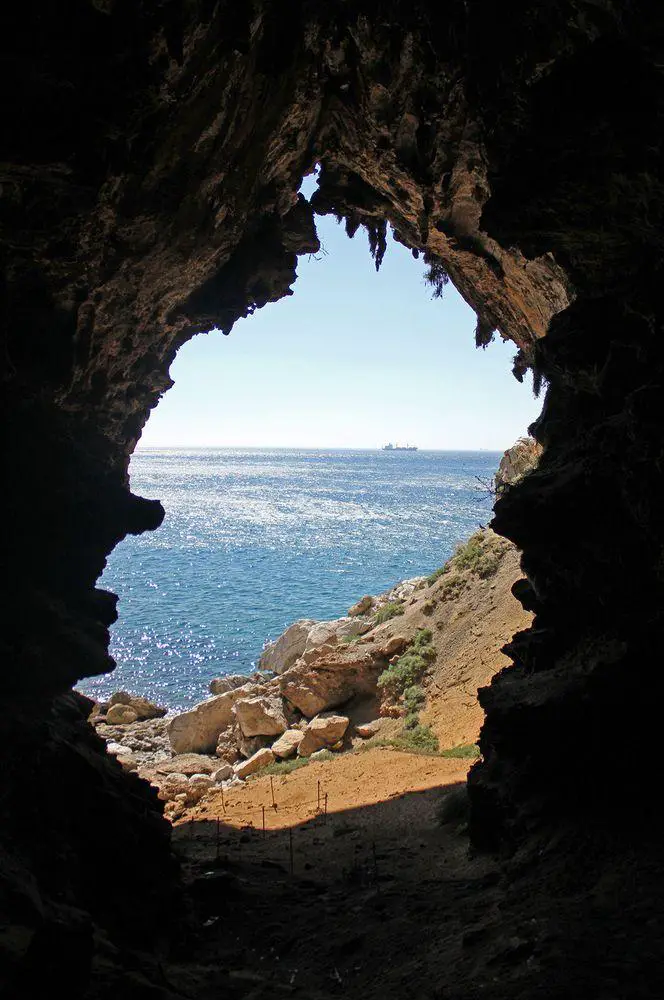
Currently this cave is just a bit above sea level and it can be accessed from the sea. During the Ice Age, when sea level in the world’s ocean, and, especially, in the Mediterranean was much lower, in front of this cave was a plain and sea was up to 5 kilometers away from it.
There are other, similar sea caves nearby.
History of discovery and exploration
Discovery
Although in prehistoric and ancient times this was a very important site, in modern times this cave was rediscovered only in 1907, by Captain A.Gorham. He wrote his name and date of discovery on the wall of the cave.
For a while this discovery was left without much notice until Royal Engineers (military engineers) Eric Keighley and Denis Ward discovered here pottery sherds, stone tools, remains of humans and animals and reported their finds to local newspapers.
Exploration
Soon after, sometime between 1945 and 1948 the first investigations were made by Lieutenant George Baker Alexander – Royal Engineer and geologist. Unfortunately, results were not published and are not known.
Test excavations took place here by Dr. John d’Arcy Waechter in September 1948. He continued excavations in 1950 – 1951, 1952, and 1954. He found out that over several periods of time this cave has been inhabited and its inhabitants have left 18 m thick layer of sediments.
Most interesting aspect of the research was the presence of Neanderthal settlement in the cave. Remnants of Neanderthals were found in Gibraltar earlier: in Forbe’s Quarry Cave already in 1848, eight years before the official discovery of Neanderthals was found a skull of this human species. In Devil’s Tower Cave in the 1920s was found a skull of some 4 years old Neanderthal child. But the most significant finds of Neanderthal culture were made in Gorham’s Cave as well as in the nearby Vanguard Cave, Hyaena Cave, and Bennett’s Cave.
Since 1989 the exploration of Gorham’s Cave continues almost every year and this research has provided us with numerous amazing discoveries and also some new mysteries waiting to be solved.
Presumed history of the cave
Who were Neanderthals?
Long before the coming of modern humans (Homo sapiens) in Europe lived another species of humans – Neanderthals (Homo neanderthalensis). They appeared some 250 thousand years ago and went extinct some 40 thousand years ago… or only 24 thousand years ago – in Gibraltar?
Neanderthals lived in Western and Southern Europe, Near East and Central Asia up to the Altai Mountains.
As modern humans left Africa some 60 thousand years ago, they met Neanderthals. Most likely they interbred and to some extent influenced the genome of people living outside Africa.
Neanderthals coexisted with Homo sapiens for some time but finally they gave up. There might be several reasons for this or a combination of these reasons: illnesses brought by modern humans, change of climate, and direct competition about the same resources between Neanderthals and modern humans.
At the end of their history Neanderthals existed in several isolated "pockets" around Europe, gradually disappearing from one, then another and finally – from the last one, most likely in Gibraltar.
Neanderthals in Gorham’s Cave
Most likely Neanderthals did not live permanently in Gorham’s Cave – they appeared here for a while, then traveled elsewhere, and then came back again. The cave is not too large – it was suitable for a family with some 15 people.
It seems, Neanderthals first came here some 55 – 47 thousand years ago when most of Europe was covered with ice but here was wooded savanna. Approximately 31 – 33 thousand years old deposits show that they hunted and ate diverse animals – turtles, ibexes, seals, dolphins, horses, hyaenas, and others. Even more diverse food remains are found in Vanguard Cave some 130 m to the north.
Neanderthals used fire – near the 90 degrees turn were found remains of hearth and burnt bones. Here were found also diverse stone tools, most were locally produced but some flakes were imported or brought from elsewhere.
Newest sediments left by Neanderthals are 23,360 years old (mistake up to 320 years), although frequently is mentioned the older, more proven date – 28 thousand years ago. This is the most recent known trace of Neanderthals – seems, since then they have been extinct. Modern humans did not reach Gibraltar until 23 thousand years ago.
By the time when Neanderthals disappeared, changed local climate and woodland savanna was replaced with pine forests.
There have been found no remains of Neanderthals or modern humans in this cave.
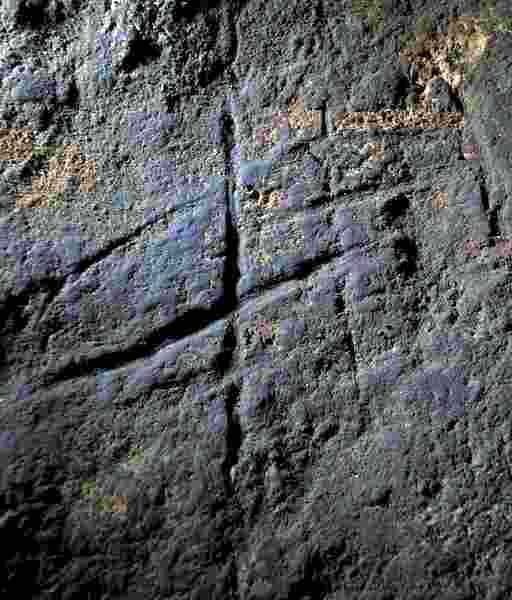
Drawing of Neanderthals?
In July 2012 there was found a rock engraving on a cliff ledge below the sediments which were some 39,000 years old – but the drawing might be significantly older. The drawing was located some 60 m deep in the cave, but it is in a well visible place, at a place where the cave turns per some 90 degrees. Near this drawing was found also hearth, thus here might be the "centre" of this cave settlement.
Engraving consists of eight lines in two groups. Three longer lines (up to 15 cm long) are intersected by two shorter lines. It is possible that this is a symbol – the oldest known abstract drawing in the world.
This drawing almost certainly was created by Neanderthals because no modern humans were here at this time. Thus it turns out that Neanderthals were capable of abstract thinking and their level of development was similar to the development of humans. There have been found more proofs of Neanderthal art elsewhere in Europe.
Prehistoric modern humans
Some 23 thousand years ago, in the Upper Paleolithic age cave was reached by modern humans. Representatives of Magdalenian and Solutrean cultures lived here and left at least 240 artifacts as well as a painting of deer, horse, aurochs, ibex, and hand imprints.
Also in the Neolithic age people occasionally stayed in this cave. These were farmers and fishermen – seems, the sea now was close to the caves.
Neanderthals and humans were not the only ones living in this cave. In different time periods here have lived also numerous birds, wolves, hyaenas and also big cats.
Phoenician shrine
In the time period between the 8th and 3rd century BC this small cave was of huge importance again – it was an important shrine for Phoenicians and Carthaginians.
Phoenicians were brave seafarers who explored also the Atlantic Ocean. It is possible that they even had colonies as far as the Azores (see the article about Monte Brasil "Phoenician sanctuaries") and they definitely reached the British Isles and other faraway lands.
It seems that they were guarding these profitable and promising sea routes, rising the Greek myth about Pillars of Hercules. Ships had to stop at Gibraltar.
Role of one such stop most likely was performed by Gorham’s Cave, supported by the nearby Phoenician city Carteia (located in the area of present-day Spain). Phoenicians and later Carthaginians left in the front part of the cave thousands of offerings including thousands of personalized scarabs from the rings of sailors, small oil lamps – incense burners. Then they waited for suitable wind and entered the ocean.
References
- The Gibraltar Museum, The Sites: Gorham’s Cave, Current Projects.
- CBS News, Did Neanderthals Last Longer?. Accessed on July 10, 2015
- Encyclopaedia Phoeniciana, The Pillars of the Phoenicians. Accessed on July 10, 2015
- R.N.E. Barton, C.B. Stringer, and J.C. Finlayson (eds.), Neanderthals in Context: A Report of the 1995–1998 Excavations at Gorham’s and Vanguard Caves, Gibraltar. Accessed on July 11, 2015
 Linked articles
Linked articles
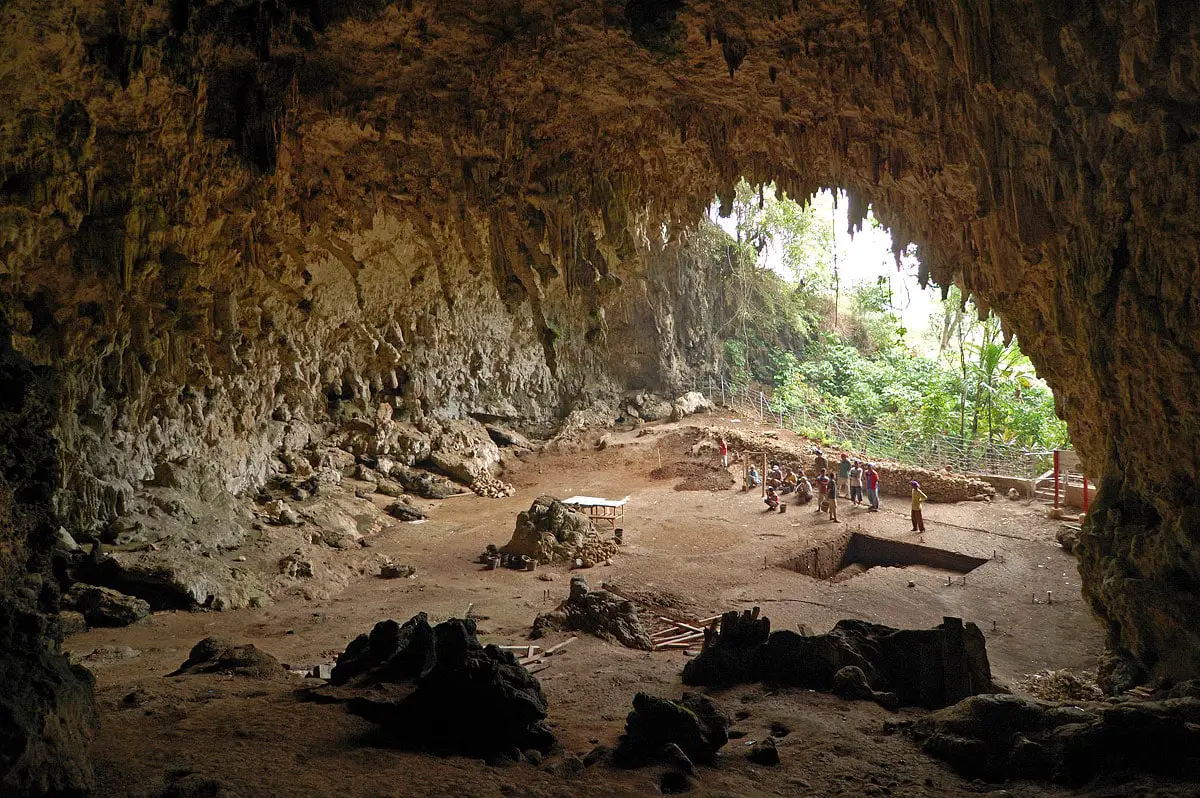
Early human finds
In this category have been included the most important and unusual places where have been found remains and other traces of activities by early humans (several species of them!) and other hominins.

Wonders of Gibraltar
Gibraltar is a British overseas territory.
Many know that Brits over the centuries have turned this cliff into a fortress but few realize that the total length of underground passages here is 55 kilometers! The small peninsula is crisscrossed with subterranean passages, many of them – secret. 24 thousand years ago Gibraltar was the last refuge of the "other" humans – Neanderthals.
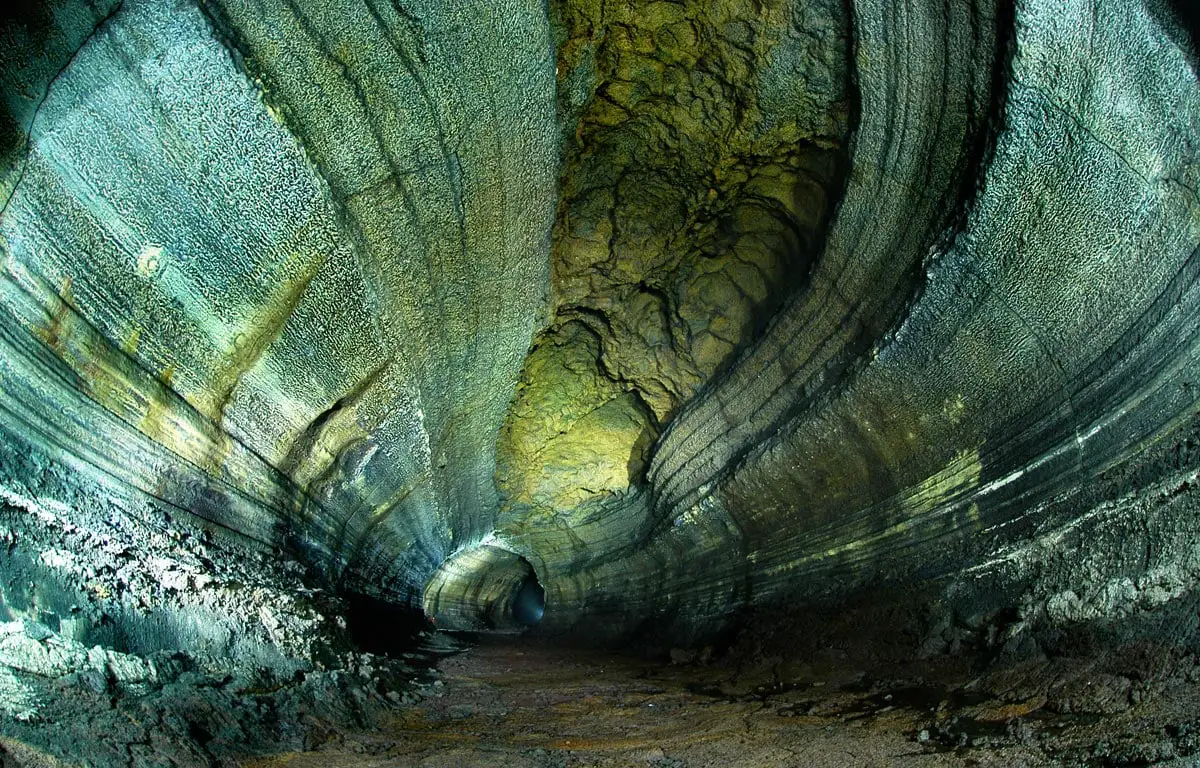
Caves
Every year there are reported exciting discoveries of new caves and discoveries of new qualities such as cave paintings in the ones known before. But there still is a feeling that our knowledge covers just a small part of all these monuments of nature.
Though, those which are known to us, offer a surprising diversity of unusual features and impressive sights.
 Recommended books
Recommended books
The Last Neanderthal: A Novel
Forty thousand years in the past, the last family of Neanderthals roams the earth. After a crushingly hard winter, their numbers are low, but Girl, the oldest daughter, is just coming of age and her family is determined to travel to the annual meeting place and find her a mate.
The Neanderthals Rediscovered: How Modern Science Is Rewriting Their Story
In recent years, the common perception of the Neanderthals has been transformed, thanks to new discoveries and paradigm-shattering scientific innovations. It turns out that the Neanderthals’ behavior was surprisingly modern: they buried the dead, cared for the sick, hunted large animals in their prime, harvested seafood, and communicated with spoken language. Meanwhile, advances in DNA technologies are compelling us to reassess the Neanderthals’ place in our own past.


